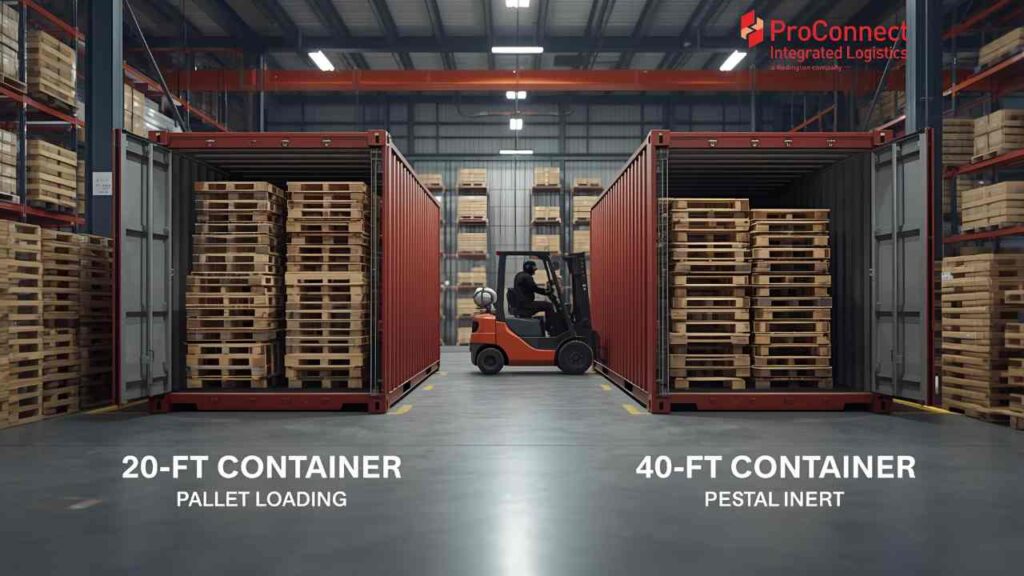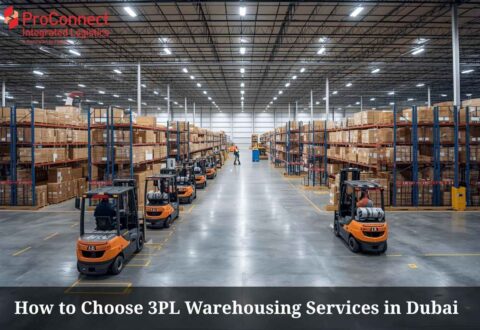In global shipping, space is precious. Whether you are moving consumer goods, machinery parts, or raw materials, knowing How Many Pallets Fit in a 20 and 40 Foot Container helps you plan efficiently. Every inch matters. The right pallet layout maximises space and keeps cargo secure.
A 20ft container suits smaller or heavier shipments, while a 40ft container handles larger volumes. The exact number of pallets depends on pallet size, cargo height, and stacking method. With smart planning, you can optimise load space, cut transport costs, and ensure safe, stable delivery.
Why Pallet Configuration Matters in Container Shipping
In freight logistics, pallet arrangement plays a key role in how efficiently a container is used. A smart configuration does not just save space it also saves time, reduces costs, and protects your cargo during transit.
Every container has limits in both volume and weight. Poor arrangement can waste space or create uneven loads, leading to delays or damage. A well-planned layout, on the other hand, uses every inch effectively and keeps the weight balanced.
A container pallet plan must consider both floor space and height. For instance, the 40ft container pallet capacity is greater, but stacking must be secure. Experienced shippers also account for cargo type, packaging, and how goods will be unloaded.

Types of Pallets Used in International Shipping
Pallets are the foundation of modern cargo movement. They make handling, loading, and unloading faster, safer, and more efficient. But not all pallets are the same. The type and size of pallet you use play a big role in determining how many you can fit inside a container.
In international trade, two main pallet types are most common – Euro pallets and Standard pallets.
| Feature | Euro Pallet (EUR / EPAL) | Standard / Industrial Pallet |
|---|---|---|
| Dimensions | 1200 mm × 800 mm | 1200 mm × 1000 mm |
| Common Regions | Europe | UK, Asia, North America |
| Surface Area | Smaller footprint, more space-efficient | Larger surface, supports bulkier loads |
| Typical Container Fit | Up to 11 pallets in a 20ft container | Up to 10 pallets in a 20ft container |
| Advantages | Better for compact loads and tighter arrangements | Ideal for heavier, wider goods |
| Usage Example | Retail goods, consumer products, mixed cargo | Machinery parts, industrial materials, heavy boxes |
Choosing the right pallet type depends on your cargo, weight, and destination. The right match improves stability, simplifies loading, and makes every container more efficient.
How Many Pallets Fit in a 20ft Container?
A 20-foot container is one of the most common units used in international freight transport. It offers a good balance between capacity, flexibility, and cost. But when planning a shipment, the question often arises “how many pallets fit in a 20ft container?”
The answer depends on the type of pallet you are using. A standard 20ft container has an internal length of around 5.9 metres, a width of 2.35 metres, and a height of 2.39 metres. These measurements define how many pallets can be placed on the container floor in one layer.
| Pallet Type | Pallet Dimensions (mm) | Pallets per 20ft Container |
|---|---|---|
| Euro Pallet (EUR / EPAL) | 1200 × 800 | 11 pallets |
| Standard Pallet (Industrial) | 1200 × 1000 | 10 pallets |
Experienced freight forwarders also factor in the maximum weight limit of a 20ft container, which usually ranges from 24,000 to 28,000 kilograms. Even if there’s physical room for more pallets, exceeding the allowed weight can cause delays, penalties, or safety risks.
In short, when estimating your 20 feet container pallet capacity, always balance both weight and volume. A well-planned load maximises space while keeping the shipment safe and compliant with transport regulations.
How Many Pallets Fit in a 40ft Container?
The 40-foot container is the workhorse of international shipping. It provides nearly double the space of a 20ft container and is ideal for medium to large volume shipments. Many businesses prefer it for its efficiency, as it allows them to move more goods in a single trip, reducing cost per unit shipped.
| Pallet Type | Pallet Dimensions (mm) | Pallets per 40ft Container |
|---|---|---|
| Euro Pallet (EUR / EPAL) | 1200 × 800 | 24 to 25 pallets |
| Standard Pallet (Industrial) | 1200 × 1000 | 20 to 21 pallets |
A 40ft container can generally accommodate 24 to 25 Euro pallets or around 20 to 21 standard pallets. The narrower width of the Euro pallet allows for a more efficient layout, filling the container with minimal wasted space.
In some cases, you can opt for a 40ft pallet wide container, which has a slightly greater internal width. These are designed specifically to maximise pallet capacity, fitting up to 30 Euro pallets or 24 standard pallets. This variation is particularly common in Europe and used when optimising space is a priority.
Standard Container Dimensions
Most international shipments use 20-foot and 40-foot containers. These are designed according to ISO standards to ensure compatibility with global freight systems. While external dimensions may look similar, it is the internal space that determines your real loading capacity.
| Container Type | Internal Length | Internal Width | Internal Height |
|---|---|---|---|
| 20ft Standard Container | 5.9 m (19’4”) | 2.35 m (7’9”) | 2.39 m (7’10”) |
| 40ft Standard Container | 12.03 m (39’6”) | 2.35 m (7’9”) | 2.39 m (7’10”) |
Factors That Affect Pallet Capacity
Knowing the standard number of pallets a container can hold is helpful, but real-world conditions often change that figure. Several factors influence how many pallets fit in a 20ft or 40ft container:
Pallet Height and Load Shape
Taller or uneven pallets limit stacking and may leave empty spaces near the ceiling, reducing overall capacity.
Cargo Weight
Even if there’s room for more pallets, total weight can restrict loading. A 20ft container pallet capacity often depends on road weight limits, while overloading a 40ft container may cause balance or safety issues.
Container Type and Design
Different containers offer varying internal dimensions. High cube or pallet wide containers fit more pallets, whereas reefer containers provide less usable space due to insulation.
What About Reefer Containers?
When transporting temperature-sensitive cargo, a reefer container is used. The term refers to a refrigerated container designed to maintain a controlled temperature throughout the shipment. It is equipped with cooling units that keep conditions between –35°C and +35°C, making it ideal for perishable goods such as food, medicine, and chemicals.
| Container Type | Pallet Type | Pallet Dimensions (mm) | Pallets per Container |
|---|---|---|---|
| 20ft Reefer Container | Euro Pallet | 1200 × 800 | 10 pallets |
| Standard Pallet | 1200 × 1000 | 9 pallets | |
| 40ft High Cube Reefer Container | Euro Pallet | 1200 × 800 | 22 to 23 pallets |
| Standard Pallet | 1200 × 1000 | 20 to 21 pallets |
Because insulation reduces internal space, pallets must be arranged carefully to allow airflow between loads. Proper circulation keeps the temperature consistent and prevents uneven cooling during long voyages.
How to Calculate Pallet Fit (Step-by-Step)
- Measure the internal dimensions of the container
- Note your pallet size
- Divide the container width and length by your pallet dimensions
- Account for spacing and structural clearance
- Multiply by the number of tiers (if stacking is possible)
- Review the total weight
Read Also- The Complete Guide to Freight Forwarding: Air vs Sea vs Road
Tips for Safe and Efficient Pallet Loading
Knowing how many pallets fit in a container is only part of the equation. The way those pallets are loaded matters just as much. Safe and efficient pallet loading not only protects your goods but also prevents costly damage or delays during transit.
Keep pallets flush within the container
Always make sure that pallets sit flat and do not extend beyond the container’s edge. Overhanging pallets can cause problems during loading, reduce space efficiency, and even damage neighbouring goods when containers are stacked tightly.
Distribute weight evenly
Balance is crucial. Place heavier pallets at the bottom or along the container’s centre line to avoid uneven weight distribution. This is especially important for road and sea transport, as unbalanced loads can affect handling and safety.
Avoid mixing pallet sizes
It is tempting to fill small gaps with different pallet types, but this can make stacking difficult and reduce stability. Using uniform pallet sizes ensures a cleaner layout and more predictable handling.
How ProConnect Can Help
Efficient container loading is not just about knowing dimensions and pallet counts. It requires experience, planning, and flawless execution. ProConnect Integrated Logistics brings all of these together to help businesses move their goods efficiently and safely across the world.
Our team understands that every shipment is unique. Cargo weight, packaging, and delivery timelines shape the right container setup. We calculate the correct 20ft or 40ft container pallet capacity, choose the most suitable container, and make sure every load is balanced and compliant with international standards.
At ProConnect, we make logistics simple, precise, and reliable. Whether you are shipping a few pallets or a full container, your goods always arrive safely and on time.
FAQs For How Many Pallets Fit in a 20 and 40 Foot Container?
How many pallets fit in a 20 container?
A standard 20ft container can usually fit 11 Euro pallets (1200 × 800 mm) or 10 Standard pallets (1200 × 1000 mm) in a single layer. The exact number may vary depending on the pallet height and how the cargo is arranged. Proper planning ensures safe stacking and full use of the container’s floor space.
How many pallets in a 40ft container?
A 40ft container typically holds 24 to 25 Euro pallets or 20 to 21 Standard pallets. The wider Euro pallets fit more efficiently within the available floor space. A pallet-wide 40ft container can accommodate up to 30 Euro pallets, offering even greater space utilisation for larger shipments.
What is the maximum weight for a 20ft container?
The maximum weight for a 20ft container is generally around 28,000 kilograms (28 tonnes), including cargo and packaging. However, road and port regulations may impose lower limits depending on the route.





 APP DOWNLOAD
APP DOWNLOAD